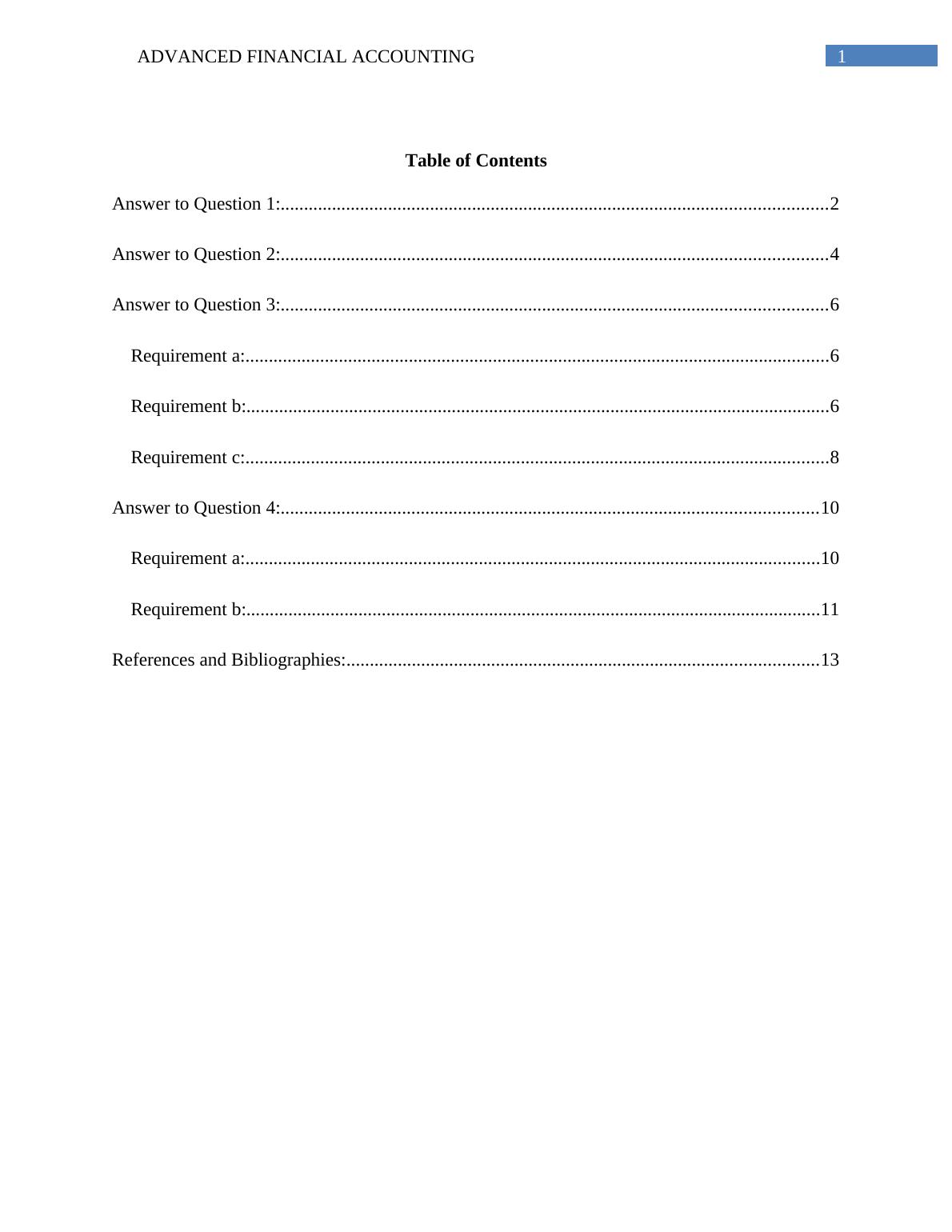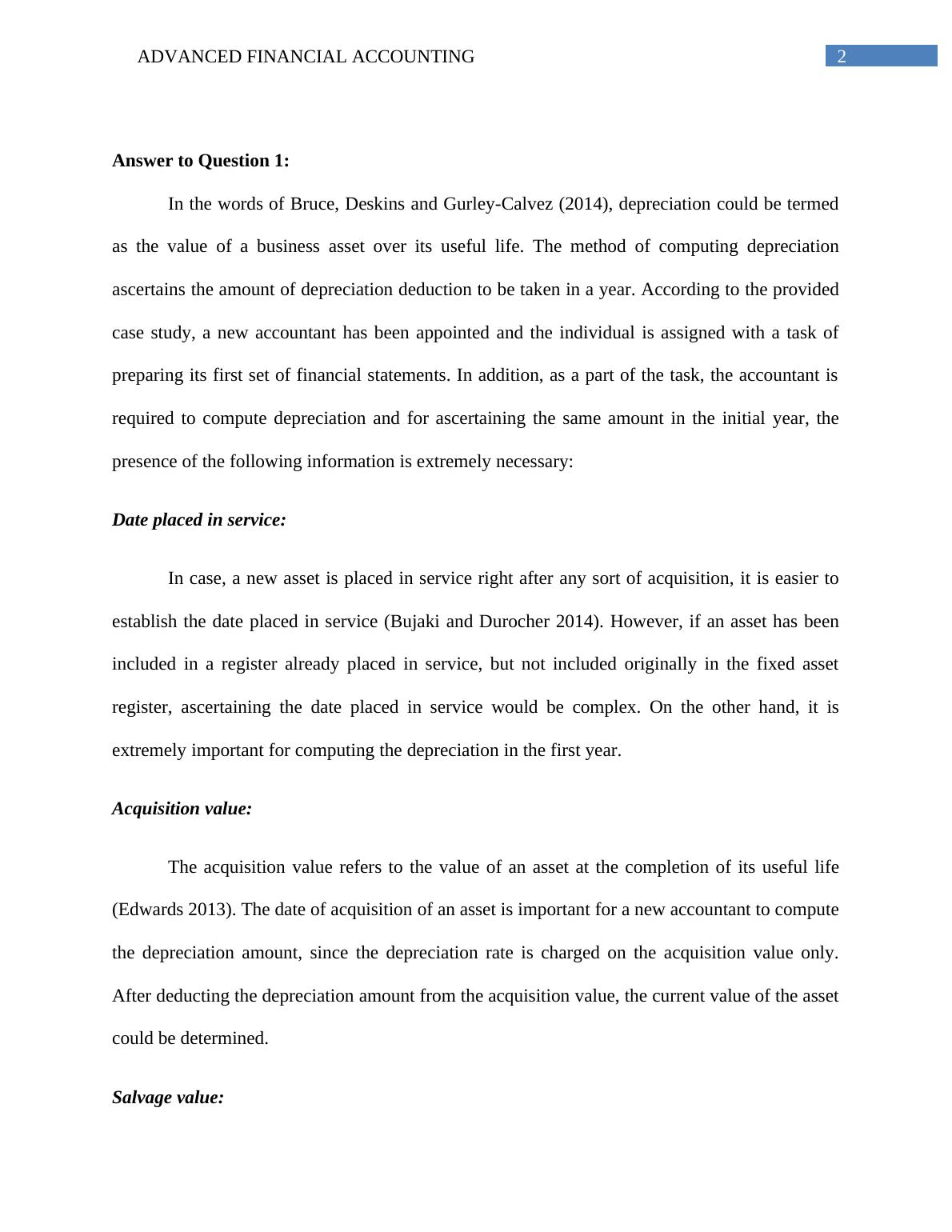ACC204 Advanced Financial Accounting
Added on 2020-05-11
13 Pages1589 Words45 Views
Running head: ADVANCED FINANCIAL ACCOUNTINGAdvanced Financial AccountingName of the Student:Name of the University:Author’s Note:Course ID:

1ADVANCED FINANCIAL ACCOUNTINGTable of ContentsAnswer to Question 1:.....................................................................................................................2Answer to Question 2:.....................................................................................................................4Answer to Question 3:.....................................................................................................................6Requirement a:.............................................................................................................................6Requirement b:.............................................................................................................................6Requirement c:.............................................................................................................................8Answer to Question 4:...................................................................................................................10Requirement a:...........................................................................................................................10Requirement b:...........................................................................................................................11References and Bibliographies:.....................................................................................................13

2ADVANCED FINANCIAL ACCOUNTINGAnswer to Question 1:In the words of Bruce, Deskins and Gurley-Calvez (2014), depreciation could be termedas the value of a business asset over its useful life. The method of computing depreciationascertains the amount of depreciation deduction to be taken in a year. According to the providedcase study, a new accountant has been appointed and the individual is assigned with a task ofpreparing its first set of financial statements. In addition, as a part of the task, the accountant isrequired to compute depreciation and for ascertaining the same amount in the initial year, thepresence of the following information is extremely necessary:Date placed in service:In case, a new asset is placed in service right after any sort of acquisition, it is easier toestablish the date placed in service (Bujaki and Durocher 2014). However, if an asset has beenincluded in a register already placed in service, but not included originally in the fixed assetregister, ascertaining the date placed in service would be complex. On the other hand, it isextremely important for computing the depreciation in the first year.Acquisition value:The acquisition value refers to the value of an asset at the completion of its useful life(Edwards 2013). The date of acquisition of an asset is important for a new accountant to computethe depreciation amount, since the depreciation rate is charged on the acquisition value only.After deducting the depreciation amount from the acquisition value, the current value of the assetcould be determined. Salvage value:

3ADVANCED FINANCIAL ACCOUNTINGThe historical cost method is used mainly for recording fixed assets. If an asset like abuilding does not hold much value, a greater formal assessment is needed to ascertain its value(Li and Hall 2016). In case of assets not included in the fixed asset register, the accountant mightattempt to research the historical costs of the items in the initial stage. If there is unavailability ofsuch information, it is allowed to estimate the amount depending on the value of an identicalasset. Estimated useful life:The estimated useful life of an asset denotes the amount of time (number of years), whichan asset could be utilised for its actual intent. Such estimated life is crucial in determining therate of depreciation (Schündeln 2013). This is because if the accountant fails to determine thedepreciation rate, it is not possible to compute the amount of depreciation. Depreciation method:The new accountant needs to obtain information from the management of theorganisation about the method of calculating depreciation. The two most common methodsinherent in the current global business environment for computing depreciation include thestraight-line method and written down value method, out of which the first one id the mostpopular (Zadorozhnii and Kafka 2016). For instance, if it is assumed that the organisation usesthe straight-line approach, the depreciation amount could be computed by subtracting the salvagevalue from the acquisition value and then dividing the remainder by the estimated useful life.There is writing off of assets evenly over the useful life course, resulting in identical depreciationeach year.

End of preview
Want to access all the pages? Upload your documents or become a member.
Related Documents
Depreciation Process in Advanced Financial Accountinglg...
|7
|1036
|286
Financial Accountinglg...
|6
|943
|272
Accounting principles- assignmentlg...
|7
|1552
|41
Taxation Assignment-1 | Doclg...
|12
|2272
|28
Asset Register Worksheets, Depreciation, Disposal of Assets - Desklib SEOlg...
|10
|1956
|68
MANAGEMENT ACCOUNTING.lg...
|4
|471
|20